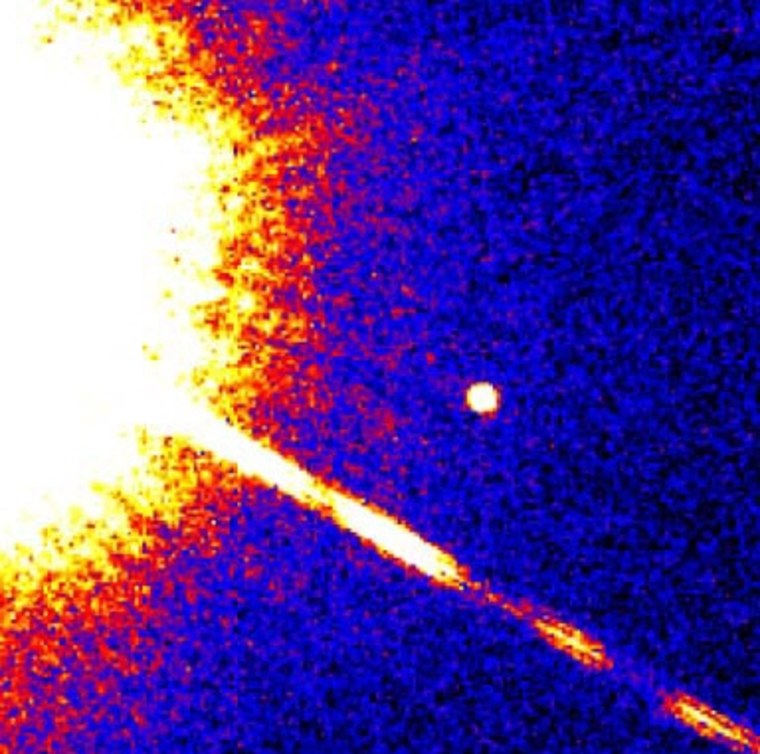Doomsayers have been wringing their hands for years over the possibility that an unseen companion to our sun periodically diverts a hail of comets toward Earth, sparking mass extinctions like cosmic clockwork. Now an astronomer has shown that the evidence for such a cycle in the flux of comets or asteroids doesn't actually exist.
The research is the latest knock against claims that the dark companion, nicknamed Nemesis or the "Death Star," might be out to get us in 2012.
Like many other 2012 myths, the Nemesis hypothesis had a smidgen of scientific research behind it. Back in 1984, paleontologists proposed that there seemed to be a 27 million-year cycle of extinctions that may have had an extraterrestrial cause. The prime suspect was a hypothetical brown dwarf or red dwarf that disrupted the orbits of comets on the solar system's fringe and sent them screaming earthward.
Nemesis has gotten swept up with the Planet X hypothesis, which holds that an as-yet-undetected planet will wreak havoc on Earth — and both those hypotheses have fed into worries about a 2012 apocalypse supposedly foretold by the ancient Maya calendar.
You've probably already figured out that the worries are totally bogus, and not just because the "long count" calendar used by the Maya was merely a calendar and not a fortune-telling device.
Last year, researchers reported that if the Nemesis companion existed, it wouldn't orbit in a nice, precise 27 million-year cycle. That study, published in the Royal Astronomical Society Letters, was portrayed as the "final nail in the coffin" for the Nemesis hypothesis. But the researchers still couldn't explain why extinctions seemed to peak every 27 million years.
"For me, it's a complete head-scratcher," University of Kansas physicist Adrian Melott said at the time.
Don't panic
Now a researcher at Germany's Max Planck Institute for Astronomy, Coryn Bailer-Jones, essentially says that Melott can stop with the scratching. His analysis, published in the Monthly Notices of the Royal Astronomical Society, suggests that the seeming periodicity may look like a pattern but actually is a statistical artifact.
"There is a tendency for people to find patterns in nature that do not exist," Bailer-Jones said in a report from the Max Planck Institute. "Unfortunately, in certain situations traditional statistics plays to that particular weakness."
Bailer-Jones looked at variations in the rate of cratering on our planet over time, using an alternative method for evaluating probabilities known as Bayesian statistical analysis. Bayesian analysis provides a reality check for statisticians who think they see patterns in their data, and in this case, the analysis ruled out simple periodic variations. Instead, the figures pointed to a steady trend of increased cratering over the past 250 million years.
Bailer-Jones said there are two possible explanations for the perceived rise: It may be that when you're looking at smaller craters, the older ones are harder to spot due to erosion. That would leave you with the impression that an increasing number of small craters are being created as you go forward through time. And in fact, Bailer-Jones said the trend toward more craters seemed to go away "if we look only at craters larger than 35 kilometers and younger than 400 million years, which are less affected by erosion and in-filling."
The other explanation would be that the increase in the cratering rate is real. The institute said some analyses of craters on the moon, where the scars left behind by cosmic collisions are not subject to erosion or in-filling, suggest the impact rate may be rising. But if scientists accept that explanation, they're left with another head-scratcher: What's causing the rising rate?
"From the crater record, there is no evidence of Nemesis," Bailer-Jones said. "What remains is the intriguing question of whether or not impacts have become ever more frequent over the past 250 million years."
Update for 9:05 p.m. ET: Over at the Bad Astronomy blog, Phil Plait clearly explains the impact (heh, heh) of Bayesian analysis on the cratering question:
"This is different than standard statistics, and is less prone to bias due to uncertainties in age and size of craters. In using standard statistics, clusters in crater ages can always be found, but it’s hard to know if that’s just a random clump or has an actual physical cause — like flipping a coin 10 times and having it come up heads 5 times in a row. It’s unlikely, but how do you know if it’s coincidence or not? Bayesian methods circumvent that issue."
More from 2012 Watch:
- The end is not near
- Don't fret over Planet X
- Stressed by storms and supernovas?
- Alien invaders vs. the truth squad
- Solar cycle sparks doomsday buzz
- French village flooded by doomsday survivalists
- 'End of the world' delayed ... by Mayan calendar
If you're looking for an additional antidote to 2012 hysteria, check out 2012hoax.org. Join the Cosmic Log community by hitting the "like" button on the blog's Facebook page or following b0yle on Twitter. You'll even find references to Planet X and 2012 hype in a chapter of my book, "The Case for Pluto."
